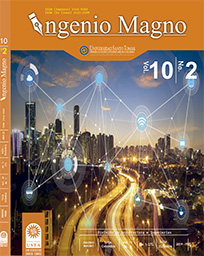Feature selection using LEM algorithm for the classification of EMG signals
Main Article Content
Abstract
Downloads
Article Details
DECLARATION OF ORGINIALITY OF SUBMITTED ARTICLE
With this document, I/We certify that the article submitted for possible publication in the institutional journal INGENIO MAGNO of the Research Center Alberto Magno CIIAM of the University Santo Tomás, Tunja campus, is entirely of my(our) own writing, and is a product of my(our) direct intellectual contribution to knowledge.
All data and references to completed publications are duly identified with their respective bibliographical entries and in the citations thus highlighted. If any adjustment or correction is needed, I(we) will contact the journal authorities in advance.
Due to that stated above, I(we) declare that the entirety of the submitted material is in accordance with applicable laws regarding intellectual and industrial property, and therefore, I(we) hold myself(ourselves) responsible for any complaint related to it.
If the submitted article is published, I(we) declare that I(we) fully relinquish publishing rights of the article to the University Santo Tomás, Tunja campus. As remuneration for this relinquishment of rights, I(we) declare my(our) agreement to receive two (2) copies of the edition of the journal in which my(our) article appears.
References
R. N. Khushaba, S. Kodagoda, M. Takruri, and G. Dissanayake, “Toward improved control of prosthetic fingers using surface electromyogram (EMG) signals,” Expert Systems with Applications, vol. 39, no. 12, pp. 10 731– 10 738, 2012.
A. Dellacasa Bellingegni, E. Gruppioni, G. Colazzo, A. Davalli, R. Sacchetti, E. Guglielmelli, and L. Zollo, “NLR, MLP, SVM, and LDA: A comparative analysis on EMG data from people with trans-radial amputation,” Journal of NeuroEngineering and Rehabilitation, vol. 14, no. 1, pp. 1–16, 2017.
Y. Du, W. Jin, W. Wei, Y. Hu, and W. Geng, “Surface EMG-based inter-session gesture recognition enhanced by deep domain adaptation,” Sensors (Switzerland), vol. 17, no. 3, pp. 6–9, 2017.
V. K, P. LS, N. SN, and P. S, “Development of Surface-EMG Based Single Finger Movement Identification and Control for a Bionic Arm,” Journal of Bioengineering & Biomedical Science, vol. 08, no. 01, pp. 1–5, 2018.
V. Kehri, R. Ingle, R. Awale, and S. Oimbe, “Techniques of EMG signal analysis and classification of neuromuscular diseases,” vol. 137, pp. 485– 491, 2017.
H. F. Hassan, S. J. Abou-Loukh, and I. K. Ibraheem, “Teleoperated robotic arm movement using electromyography signal with wearable Myo armband,” Journal of King Saud University - Engineering Sciences, no. xxxx, 2019. [Online]. Available: https://doi.org/10.1016/j.jksues.2019.05.001
A. Phinyomark, P. Phukpattaranont, and C. Limsakul, “Feature reduction and selection for EMG signal classification,” Expert Systems with Applications, vol. 39, no. 8, pp. 7420–7431, 6 2012.
F. Riillo, L. R. Quitadamo, F. Cavrini, E. Gruppioni, C. A. Pinto, N. C. Pasto, L. Sbernini, L. Albero, and G. Saggio, “Optimization ` of EMG-based hand gesture recognition: Supervised vs. unsupervised data preprocessing on healthy subjects and transradial amputees,” Biomedical Signal Processing and Control, vol. 14, no. 1, pp. 117–125, 2014. [Online]. Available: http://dx.doi.org/10.1016/j.bspc.2014.07.007
U. Cotˆ e-Allard, C. L. Fall, A. Drouin, A. Campeau-Lecours, C. Gos- ´ selin, K. Glette, F. Laviolette, and B. Gosselin, “Deep Learning for Electromyographic Hand Gesture Signal Classification Using Transfer Learning,” IEEE Transactions on Neural Systems and Rehabilitation Engineering, vol. 27, no. 4, pp. 760–771, 2019.
P. Sattam and B. Abdulaziz, “Deep Learning of EMG Time – Frequency Representations for Identifying Normal and Aggressive Actions,” vol. 18, no. 12, pp. 16–25, 2018.
F. Gomez-Donoso, S. Orts-Escolano, and M. Cazorla, “Largescale multiview 3D hand pose dataset,” Image and Vision Computing, vol. 81, pp. 25–33, 2019. [Online]. Available: https://doi.org/10.1016/j.imavis.2018.12.001
R. Li, Z. Liu, and J. Tan, “A survey on 3D hand pose estimation: Cameras, methods, and datasets,” Pattern Recognition, vol. 93, pp. 251– 272, 2019.
A. Carf`ı, F. Foglino, B. Bruno, and F. Mastrogiovanni, “A multi-sensor dataset of human-human handover,” Data in Brief, vol. 22, pp. 109–117, 2019. [Online]. Available: https://doi.org/10.1016/j.dib.2018.11.110
S. Pizzolato, L. Tagliapietra, M. Cognolato, M. Reggiani, H. Muller, and ¨ M. Atzori, “Comparison of six electromyography acquisition setups on hand movement classification tasks,” PLoS ONE, vol. 12, no. 10, pp. 1–17, 2017.
J. S. Kim and S. B. Pan, “A Study on EMG-based Biometrics,” Journal of Internet Services and Information Security, vol. 2, no. May, pp. 19– 31, 2017.
J. F.-s. L. B, A.-a. Samadani, and D. Kuli, “Segmentation by Data Point Classification Applied to Forearm Surface EMG,” vol. 166, pp. 153–165, 2016. [Online]. Available: http://link.springer.com/10.1007/978-3- 319- 33681-7
A. Phinyomark and E. Scheme, “EMG Pattern Recognition in the Era of Big Data and Deep Learning,” Big Data and Cognitive Computing, vol. 2, no. 3, p. 21, 2018.
M. Atzori, A. Gijsberts, C. Castellini, B. Caputo, A. G. M. Hager, S. Elsig, G. Giatsidis, F. Bassetto, and H. Muller, “Electromyography ¨ data for non-invasive naturally-controlled robotic hand prostheses,” Scientific Data, vol. 1, pp. 1–13, 2014.
J. E. Goez Mora, J. C. Londono Lopera, and D. A. Pati ˜ no Cortes, ˜ “Automatic Visual Classification of Parking Lot Spaces: A Comparison Between BoF and CNN Approaches,” in Communications in Computer and Information Science, 2018, pp. 160–170. [Online]. Available: http://link.springer.com/10.1007/978-3- 030-00350-014
R. S. Michalski and L. Saitta, “Learnable Evolution Model: Evolutionary Processes Guided by Machine Learning,” Machine Learning, vol. 38, no. 1, pp. 9– 40, 2000. [Online]. Available: http://dx.doi.org/10.1023/A:1007677805 582.
G. Sheri and D. W. Corne, “The simplest evolution/learning hybrid: LEM with KNN,” in 2008 IEEE Cong.

